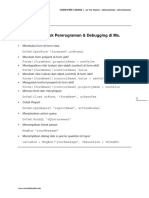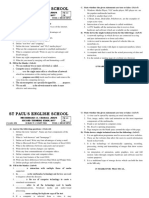0 ratings0% found this document useful (0 votes)
48 viewsSpringBoot Framework
The document provides an overview of the key aspects of the Spring Boot framework. It discusses how Spring Initializr is used to bootstrap Spring Boot applications and configure dependencies and metadata. It also describes implementing REST APIs with Spring Boot using annotations like @RestController and @RequestMapping. Additionally, it covers topics like model classes, controllers, services, configuration, repositories, relationships, and using Spring Data JPA.
Uploaded by
Karan GMCopyright
© © All Rights Reserved
We take content rights seriously. If you suspect this is your content, claim it here.
Available Formats
Download as PDF, TXT or read online on Scribd
0 ratings0% found this document useful (0 votes)
48 viewsSpringBoot Framework
The document provides an overview of the key aspects of the Spring Boot framework. It discusses how Spring Initializr is used to bootstrap Spring Boot applications and configure dependencies and metadata. It also describes implementing REST APIs with Spring Boot using annotations like @RestController and @RequestMapping. Additionally, it covers topics like model classes, controllers, services, configuration, repositories, relationships, and using Spring Data JPA.
Uploaded by
Karan GMCopyright
© © All Rights Reserved
We take content rights seriously. If you suspect this is your content, claim it here.
Available Formats
Download as PDF, TXT or read online on Scribd
You are on page 1/ 33
SpringBoot Framework
By: Karan G.M
INTRODUCTION
● Most popular framework.
● Includes everything you need to build an application.
● Beginner friendly.
● Production ready.
● Dependency injection is built in.
SPRING INITIALIZR
● Bootstrapping Springboot application.
● Allows to select:
○ Project Type: Maven/Graddle
○ Language: Java/Kotlin/Groovy
○ Spring version
● Defines Metadata
● Selects Java version & Packaging.
● Allows to add dependencies that our project needs.
FOLDER STRUCTURE
● Main
○ Java
■ Project package
● Model Package
○ Controllers/Models/Re
positories/Service/Con
fig
● DemoApplication(Main)
○ Resources
■ Static
■ Templates
■ Application properties
● Test
IMPLEMENTING REST API WITH SPRINGBOOT
● @RestController
● @GetMapping
● @PostMapping
● @PutMapping
● @DeleteMapping
● @RequestMapping(path=”url”)
PASSING PARAMS
● @PutMapping(path=”{studentId}”)
● Function name (@PathVariable(“studentId”) Long id,
@RequestParam(required = false) String name){}
MODEL
● Class representation of the table in the database.
● It defines all the attributes in the table.
● Provides data access to the controller.
CREATING THE MODEL
● Create a package inside jav->com.example.”project name”->”package name”.
● Inside package define the class.
● Add @Getter and @Setter
● @Entity - maps the class to the database.
● @Table - maps the class to a table.
● @NoArgsConstructor
● @AllArgsConstructor
SEQUENCE GENERATOR
● Used to generate values for primary key.
CONTROLLER
● Handles requests and response
● Connects frontend with backend
CREATING A CONTROLLER
● Create a class “ModelNameController” inside the model package.
● @RestController
● @RequestMapping(path=”url”)
● Create functions and map it to the correct request.
● Controller functions don’t have business logic.
● Calls function in the Service class for Business logic.
SERVICE
● Functions contain business logic.
● Functions invoked from Controller.
● The business logic accesses data from the database through the Model.
CONFIG
● @Configuration: indicates that the class has @Bean definition methods.
● @Bean Annotation is applied on a method to specify that it returns a bean to be
managed by Spring context.
● CommandLineRunner(“Repository Class”)
REPOSITORY
● Interface for working with JPA
● Extends JpaRepository
● Used in Service Class.
● Used for accessing database using JPQL.
● @Repository
● @Query
REST API
REST (Representational State Transfer )
● Sends request via uri to server using HTTP protocol.
● Server sends response back.
● Fixed set of Operations (GET, PUT, POST, DELETE).
● Data from server can be accessed as HTML, XML, JSON etc.
SPRING DATA JPA
WHY SPRING DATA JPA
Spring Data JPA aims to significantly improve the implementation of data
access layers by reducing the effort to the amount that's actually needed.
As a developer you write your repository interfaces, including custom
finder methods, and Spring will provide the implementation automatically.
PRIMARY KEY
CONSTRAINTS
● @Table( name=”table_name”,
uniqueConstraint = @UniqueConstraint(
name = “email_unique”,
columnNames = “email_address”
● @Column(name = “email_address”, nullable=false)
CUSTOM ATTRIBUTE NAME
● @AttributeOverride(name = "identifier", column = @Column(name = "VIN"))
FUNCTIONS THAT PERFORM QUERIES
NATIVE SQL QUERIES
● @Query(
value = “SELECT * FROM tbl_students s WHERE s.email = ?1,
nativeQuery = true
Student getStudentByEmail(String emailAddress);
NAMED PARAMS QUERIES
● @Query(
value = “SELECT * FROM tbl_students s WHERE s.email = “email_Id,
nativeQuery = true
Student getStudentByEmail(@Param(“email_Id) String emailAddress);
UPDATE & DELETE
● @Modifying
● @Transactional
● @Query(“query for updating”)
RELATIONSHIPS
WHY USE RELATIONSHIPS
● Avoid complex queries.
● Avoid Join Queries.
● Makes the code more readable.
● Easy to use.
ONE TO ONE
● Each course has one course material.
● @OneToOne (
cascade = CascadeType.All(),
fetch = FetchType.(Lazy/Eager)
)@JoinColumn(name = “course_id[name of column in table]”,
referencedColumnName = “id”[name of mapped attribute in class])
-> Do this in courseMaterials class.
BiDirectional
● @OneToOne(
mappedBy = “course[name of instance of this class in the other class]”
)->in Course class
ONE TO MANY
● One Teacher can teach many courses.
● @OneToMany(
..
)@JoinColumn( name = “teacher_id” , refferencesColumn = “teacherId”)
private List<Course> courses;
MANY TO ONE
● One Teacher can teach many courses.
● @ManyToOne(
..
)@JoinColumn( name = “teacher_id” , refferencesColumn = “teacherId”)
private List<Teacher> teacher;
MANY TO MANY
● Many students can access many courses.
● An intermediate table is created for defining the mapping.
● @ManyToMany(cascade = CascadeType.All())
@JoinTable(name = “student_course_mapping”,
joinColumn = @JoinColumn(name = “course_id”, refferencedColumnName =
“courseId”),
inverseJoinColumns = @JoinColumn(name = “student_id”,
refferencedColumnName = “StudentId”))
private List<Student> students; ->defined in course class.
THANK YOU
You might also like
- Steps For Creating Spring Boot ApplicationNo ratings yetSteps For Creating Spring Boot Application3 pages
- Spring Boot, MySQL, JPA, Hibernate Restful CRUD API TutorialNo ratings yetSpring Boot, MySQL, JPA, Hibernate Restful CRUD API Tutorial15 pages
- IGNOU PGDCA MCS 206 Object Oriented Programming using Java Previous Years solved PapersFrom EverandIGNOU PGDCA MCS 206 Object Oriented Programming using Java Previous Years solved PapersNo ratings yet
- Chapter 1 Spring Boot Intro and Installation and Demo Project Day 2 - Google DocsNo ratings yetChapter 1 Spring Boot Intro and Installation and Demo Project Day 2 - Google Docs20 pages
- Chapter III SpringBoot - Part 4 - RepositoryNo ratings yetChapter III SpringBoot - Part 4 - Repository22 pages
- Building a Robust REST API With Spring Boot, H2 DatabaseNo ratings yetBuilding a Robust REST API With Spring Boot, H2 Database12 pages
- Spring+SpringBoot+Microservices - ContentNo ratings yetSpring+SpringBoot+Microservices - Content5 pages
- Spring Boot Thymeleaf CRUD Database Real-Time ProjectNo ratings yetSpring Boot Thymeleaf CRUD Database Real-Time Project58 pages
- Lecture 2 - Spring Data and Spring Data RestNo ratings yetLecture 2 - Spring Data and Spring Data Rest47 pages
- Data With JPA - Spring Data and JPA Cheatsheet - CodecademyNo ratings yetData With JPA - Spring Data and JPA Cheatsheet - Codecademy3 pages
- Java Programming Tutorial With Screen Shots & Many Code ExampleFrom EverandJava Programming Tutorial With Screen Shots & Many Code ExampleNo ratings yet
- IBM Tivoli Provisioning Manager V7.1.1 Deployment and IBM Service Management Integration Guide Sg247773No ratings yetIBM Tivoli Provisioning Manager V7.1.1 Deployment and IBM Service Management Integration Guide Sg247773762 pages
- Step by Step How To Deploy RemoteApp in Windows Servernbsp2016No ratings yetStep by Step How To Deploy RemoteApp in Windows Servernbsp201612 pages
- AI-6A Fusion Splicer DataSheet - WiitekNo ratings yetAI-6A Fusion Splicer DataSheet - Wiitek14 pages
- Introduction To Writing Device Drivers For WindowsNo ratings yetIntroduction To Writing Device Drivers For Windows20 pages
- Manual de Instalacion Gps Teltonika FM1202100% (1)Manual de Instalacion Gps Teltonika FM120282 pages
- Microprocessor Architecture Question BankNo ratings yetMicroprocessor Architecture Question Bank4 pages
- QATestLab Testing Check Lists Project NameNo ratings yetQATestLab Testing Check Lists Project Name7 pages
- Final ENCE 455 - ADVANCED MICROPROCESSOR SYSTEMS AND INTERFACING EXAMS - NOV 2021No ratings yetFinal ENCE 455 - ADVANCED MICROPROCESSOR SYSTEMS AND INTERFACING EXAMS - NOV 20218 pages
- Essential Hadoop Tools: Module - 2 Session - 2No ratings yetEssential Hadoop Tools: Module - 2 Session - 26 pages
- Online Proctored Exam Instructions - New Link - 29 March 2024No ratings yetOnline Proctored Exam Instructions - New Link - 29 March 20247 pages
- How To Convert Windows 10 From Legacy BIOS To UEFNo ratings yetHow To Convert Windows 10 From Legacy BIOS To UEF3 pages

























































































